
Lagodon is a monospecific genus of marine ray-finned fish belonging to the family Sparidae, which includes the seabreams and porgies. The only species in the genus is Lagodon rhomboides, the pinfish, red porgy, bream, pin perch, sand perch, butterfish or sailor's choice. This fish is found in the Western Atlantic Ocean and Gulf of Mexico.

The pluma porgy, also known as the West Indian porgy, pluma or pimento grunt, is a species of marine ray-finned fish belonging to the family Sparidae, the seabreams and porgies. This species is found in the Western Atlantic Ocean.

The saddled seabream, also called the saddle bream or oblade, is a species of ray-finned fish belonging to the family Sparidae, which includes the seabreams and porgies. It is the only species in the monospecific genus Oblada. This species is found in the Eastern Atlantic Ocean. It is an important food fish within its range.

Diplodus sargus, the sargo, common white seabream, or white seabream is a species of marine ray-finned fish belonging to the family Sparidae, which includes the seabreams and porgies. This fish is found in the eastern Atlantic Ocean and in the Mediterranean Sea. It is a target species for commercial fisheries and is grown in aquaculture. D. sargussensu lato was formerly thought to be a widespread species in the eastern Atlantic and western Indian Oceans but the taxa outside of D, sargussensu stricto are now recognised as valid species and are part of the D. sargus species complex.

Diplodus is a genus of marine ray-finned fish belonging the family Sparidae, which includes the seabreams and porgies. These fishes are found in the Atlantic Ocean, the Mediterranean Sea and the western Indian Ocean.
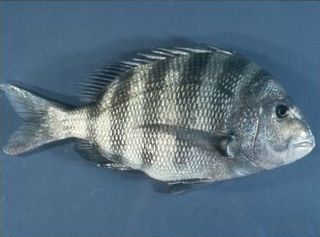
Archosargus is a genus of marine ray-finned fishes belonging to the family Sparidae, the sea breams and porgies. These fishes occur in the Western Atlantic and Eastern Pacific Oceans.

Diplodus vulgaris, the common two-banded sea bream, is a species of marine ray-finned fish belonging to the family Sparidae, which includes the seabreams and porgies. This species is found in the northeastern Atlantic Ocean and the Mediterranean. It is an important species for fisheries and is grown in aquaculture.

Rhabdosargus sarba, also known as the goldlined seabream, silver bream, tarwhine, or yellowfin bream, is a species of marine ray-finned fish belonging to the family Sparidae, which includes the seabreams and porgies. This fish has a wide Indo-Pacific distribution.

Diplodus cervinus, the zebra sea bream, is a species of marine ray-finned fish belonging to the family Sparidae, which includes the seabreams and porgies. This species is found in the temperate north eastern Atlantic Ocean and the Mediterranean Sea.
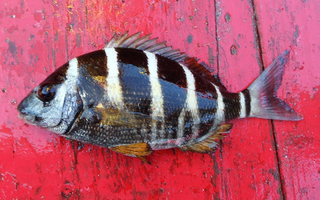
The banded seabream is a species of marine ray-finned fish belonging to the family Sparidae, which includes the seabreams and porgies. This species is endemic to Cape Verde in the eastern Atlantic Ocean.
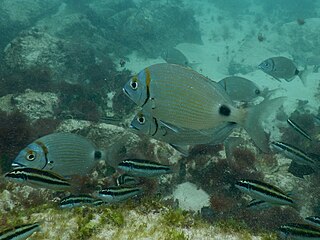
Diplodus prayensis, the two-banded seabream, is a species of marine ray-finned fish belonging to the family Sparidae, which includes the seabreams and porgies. This species is endemic to the Cape Verde Islands.
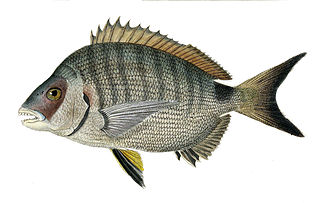
The St. Helena white seabream is a species of marine ray-finned fish belonging to the family Sparidae, which includes the seabreams and porgies. This fish is endemic to the island of Saint Helena in the southern Atlantic.

Diplodus hottentotus, the zebra, is a species of marine ray-finned fish belonging to the family Sparidae, which includes the seabreams and porgies. This fish is found in the Western Indian Ocean off Southern Africa.
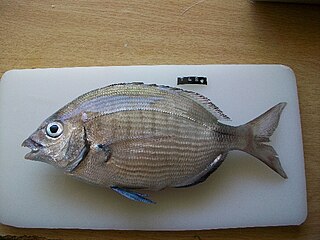
Diplodus capensis, the Cape white seabream or blacktail seabream, is a species of marine ray-finned fish belonging to the family Sparidae, which includes the seabreams and porgies. This fish is found around the coasts of Southern Africa.

Diplodus annularis, the annular seabream is a species of marine ray-finned fish belonging to the family Sparidae, the family which includes the seabreams and porgies. This species is found in the Eastern Atlantic Ocean and Mediterranean.

Rhabdosargus globiceps, the white stumpnose or go-home fish, is a species of marine ray-finned fish belonging to the family Sparidae, which includes the seabreams and porgies. This fish is endemic to the waters off Southern Africa.
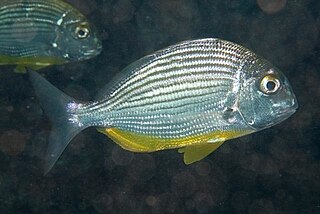
Rhabdosargus thorpei, the bigeye stumpnose, is a species of marine ray-finned fish belonging to the family Sparidae, which includes the seabreams and porgies. The bigeye stumpnose is endemic to the southwestern Indian Ocean.

Rhabdosargus haffara, the haffara seabream or Haffara stumpnose, is a species of marine ray-finned fish belonging to the family Sparidae, which includes the seabreams and porgies. This fish is found in the northwestern Indian Ocean.
Rhabdosargus niger, the blackish stumpnose, is a species of marine ray-finned fish belonging to the family Sparidae, which includes the seabreams and porgies. This fish is known only from the western coast of Kalimantan in Indonesia.

Diplodus argenteus, the silver porgy, is an ocean-going species of sparid fish (seabream/porgies). It is also called the South American silver porgy and the white bream in Uruguay, plus the silver seabream and the sargo, though the latter three names are also used for other fish species as well.





















